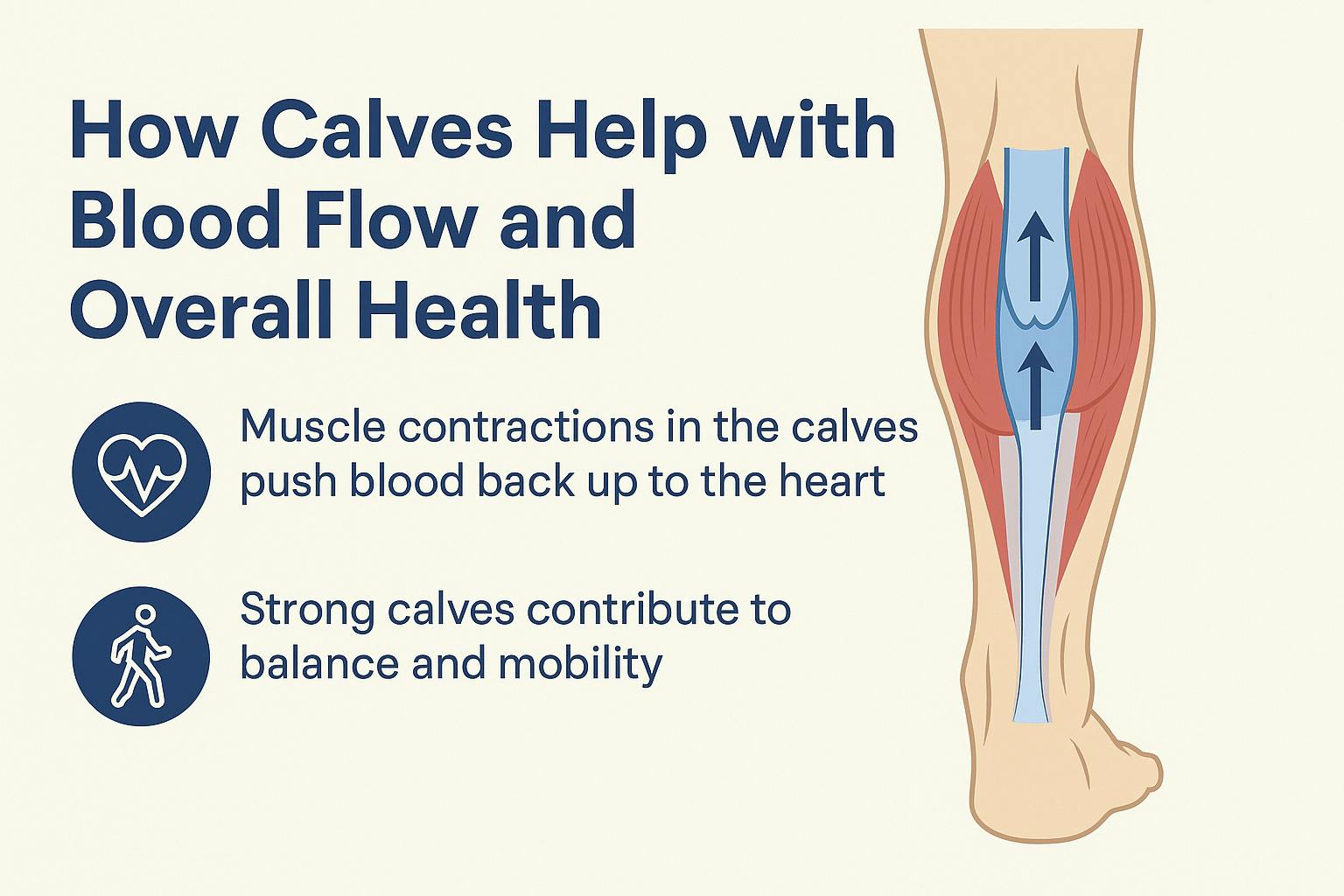
Think of your calves as more than just a muscle for walking—they’re your body’s second heart, your secret weapon for balance, and a key player in your overall health. These powerful muscles do a lot of heavy lifting, both literally and figuratively. Caring for your calves now supports long-term mobility, comfort, and overall well-being.
Your Calves Are Part of Your Circulatory System
Your calf muscles do more than move you forward—they help push blood back up to your heart. That’s why they’re often referred to as the “second heart.” Every time you walk, flex, or even shift your weight, your calves contract. This action squeezes the veins in your lower legs, which are equipped with one-way valves. This “muscle pump” helps push blood past these valves and back toward your heart, fighting gravity and preventing blood from pooling in your legs.
When these muscles are weak, tight, or underused (think long hours sitting at a desk), circulation can suffer. This can lead to swelling in the legs, varicose veins, and even increase the risk of developing blood clots. People with diabetes, POTS (postural orthostatic tachycardia syndrome), or poor circulation often benefit from exercises that specifically target calf function.
Simple fix: Try seated or standing heel raises a few times a day—especially if you sit for long stretches.

Balance and Fall Prevention Start at the Calves
Balance doesn’t just come from your inner ear or brain—it also depends heavily on your calves. These muscles help control ankle movement and stabilize your body when you stand, walk, or change direction.
In older adults, weak or slow-reacting calves can be a hidden risk factor for falls. If your calves can’t respond quickly when you stumble or lose balance, it’s harder to recover. Strengthening and training these muscles can significantly improve postural stability and confidence when walking.
Tight Calves Can Trigger Bigger Problems
Tight calves don’t just make you uncomfortable—they can throw off your entire kinetic chain. This is the interconnected system of muscles and joints that work together to create movement. Imagine your calves are like a tight spring. When you walk, they can’t fully extend, forcing your ankle and foot to overcompensate. Over time, this can lead to stress and pain in other parts of your body.
Limited flexibility or mobility in the calves can lead to:
- Plantar fasciitis
- Achilles tendon pain
- Shin splints
- Knee, hip, and even low back pain
Stretching helps, but it’s not the whole answer. Calf health requires a balance of flexibility, strength, and control.
Your Calves and Brain Health Are Connected
Believe it or not, working your calves also activates your brain. Movements like walking, stair climbing, or balance challenges involve coordinated muscle activity and neural signaling. These are key ingredients for brain health—especially as we age.
That’s why calf-strengthening and balance exercises are often part of neuro-rehabilitation programs for conditions like Parkinson’s disease, stroke recovery, or mild cognitive impairment. Keeping your lower legs strong and responsive supports both physical independence and cognitive function.
How to Show Your Calves Some Love

- Strengthen them: Include heel raises, toe walks, and stair climbing in your weekly routine. For a bigger challenge, try single-leg calf raises.
- Stretch mindfully: Don’t just stretch your calves when they feel tight. Make it part of your cool-down or daily mobility practice. A simple wall stretch is an effective way to improve flexibility.
- Keep them moving: If you work at a desk or stand still a lot, take “movement breaks” every 30–60 minutes. Flex and extend your ankles, or walk in place.
- Wear supportive footwear: Especially if you’re on your feet all day or have high or low arches. Look for shoes with a firm heel counter and good arch support.
- Consider foam rolling: Using a foam roller or massage ball can help release tension in the calf muscles and the surrounding fascia, the connective tissue that can also limit mobility.
- Stay hydrated: Drink plenty of water and make sure you’re getting enough electrolytes like potassium and magnesium, which can help prevent painful muscle cramps.
When to Get a Professional Evaluation
If you’re dealing with recurring foot pain, frequent leg cramps, balance problems, or notice swelling in your lower legs, don’t ignore it. These symptoms may signal an underlying issue with calf function or circulation.
A note of caution: Sudden, severe pain, swelling, warmth, or redness in one calf could be a sign of a deep vein thrombosis (DVT), a serious blood clot that requires immediate medical attention. If you suspect this, seek urgent care.
For other less severe issues, a physical therapist can assess your mobility, strength, and walking mechanics—and create a tailored plan to help you move and feel better.
Let Atlantis Physical Therapy Help You Stay on Your Feet—Literally
At Atlantis Physical and Occupational Therapy, we don’t overlook the small stuff—because in your body, nothing is small when it comes to movement. Our expert team can help you address calf tightness, balance concerns, or nagging leg and foot issues before they lead to bigger problems.
Located in Torrance, we specialize in personalized care that helps you move better, feel better, and stay active for the long haul.
Ready to step forward with confidence? Contact us today to schedule an evaluation.
